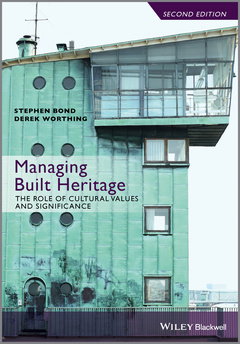Managing Built Heritage (2nd Ed.) The Role of Cultural Values and Significance
Auteurs : Bond Stephen, Worthing Derek

This new edition examines management of built heritage through the use of values-led decision making, based on an understanding of the significance of the cultural asset. It considers how significance is assessed and used as an effective focus and driver for management strategies and processes.
The authors consider key policies and procedures that need to be implemented to help ensure effective management. The book will be useful for specialists in built heritage - conservation officers, heritage managers, architects, planners, engineers and surveyors - as well as for facilities and estates managers whose building stock includes protected or designated structures or buildings in conservation or other historic areas.
- describes management strategies and tools for a wide range of built heritage assets
- a reflective and informative guide on current conservation management
- explains how understanding and using conservation values (significance ) is essential to the protection of the built heritage
- uses real-life examples to draw out best practice
About the Authors ix
1 Introduction 1
Note 3
References 4
2 Heritage Assets: Their Nature and Management Implications 5
Introduction 5
Some introductory thoughts about heritage assets 6
Heritage assets and their management implications 8
Owners, managers and management approaches 45
References 46
3 Heritage Values and Cultural Significance 49
Benefits of conservation 50
Understanding the cultural significance of a heritage asset 57
Development in the idea of values 58
Value characterisation: typologies 62
Categories of values 66
Some examples of assets and their values 73
References 82
4 Assessing Significance 85
Establishing and analysing the origins and development of an asset 85
Gathering evidence about significance 86
Research and types of evidence 88
Primary source material 90
Secondary material 97
Interpreting the building/physical remains 99
Establishing and analysing the character, dynamics and setting of the asset 100
Assessing community values 104
Analysing significance 107
Assessing significance: comparisons and relativity 108
Comparisons 111
Some issues in value assessment 113
Sensitivity to change 116
References 118
5 Using Significance in Management Tools and Processes 121
Introduction 121
The conservation plan 122
The management plan 143
Management tools for historic areas 149
Historic area appraisals 151
Characterisation 156
Heritage impact assessments 160
Heritage statements within the development planning process 172
Local management agreements 174
Care, design and quality standards guidance 179
References 184
6 Maintenance Management 187
Introduction 187
A strategic perspective 189
Recording 192
Financial management of maintenance management 213
Information management in maintenance management 214
Performance indicators 214
References 215
7 Sustainability, Built Heritage and Conservation Values: Some Observations 217
Introduction 217
Sustainable development 217
Sustainability and the built heritage 219
Trade-offs 220
Charters and guidance documents 221
Sustainable management of historic buildings 225
References 227
8 Conservation Principles 229
Introduction 229
Development of conservation principles 229
Core conservation principles 230
The relationship between significance-based management and traditional conservation principles 239
References 240
9 Case Studies 243
Case Study 1: Royal Dart Hotel, Kingswear, Devon, England 243
Case Study 2: Baixa, Maputo, Mozambique 249
Case Study 3: The Site of the Former Taunton Gaol, Taunton, Somerset, England 253
Case Study 4: Maintaining the Commonwealth War Graves 256
References 266
Index 267
Stephen Bond runs UK-based consultancy, Heritage Places, providing advice for the historic environment to national and local government, management and institutional clients, and charitable trusts. In the 1990s, he undertook a seven year secondment to Historic Royal Palaces, initially as its Surveyor of the Fabric, and subsequently as Director of the Tower Environs Scheme - a major regeneration scheme focused on the urban setting of the Tower of London. Today he works throughout the UK and on international projects, most recently providing heritage input into area-wide plans and capacity building programmes in Africa, Asia and Europe. He was involved with the Masters Programme in Conservation of the Historic Environment at the College of Estate Management for more than 20 years, lectures widely on heritage matters, and holds an honorary doctorate from De Montfort University.
Derek Worthing has a professional background as an academic and a Chartered Building Surveyor. Until recently he was Head of the School of Land and Property Management at the University of the West of England where he was also co-director of the Centre for the Study of Sustainable Buildings in the Faculty of the Built Environment. He has carried out consultancy work in relation to the built cultural heritage for a number of national UK heritage organisations and has published research papers in relation to conservation plans and the maintenance and repair of listed buildings. He now works as a consultant and as a visiting professor at Uppsala University in Sweden where he has carried out research on the sustainable management of built cultural heritage as well as work on conservation plans for the Swedish Heritage Board.
Date de parution : 05-2016
Ouvrage de 280 p.
17.3x24.4 cm
Thème de Managing Built Heritage :
Mots-clés :
guide; built; informative; practical measures; edition; conservation; new; offers; current; valuesled; examine; understanding; significance; decision; use; driver; effective; processes; significant; clear; asset



